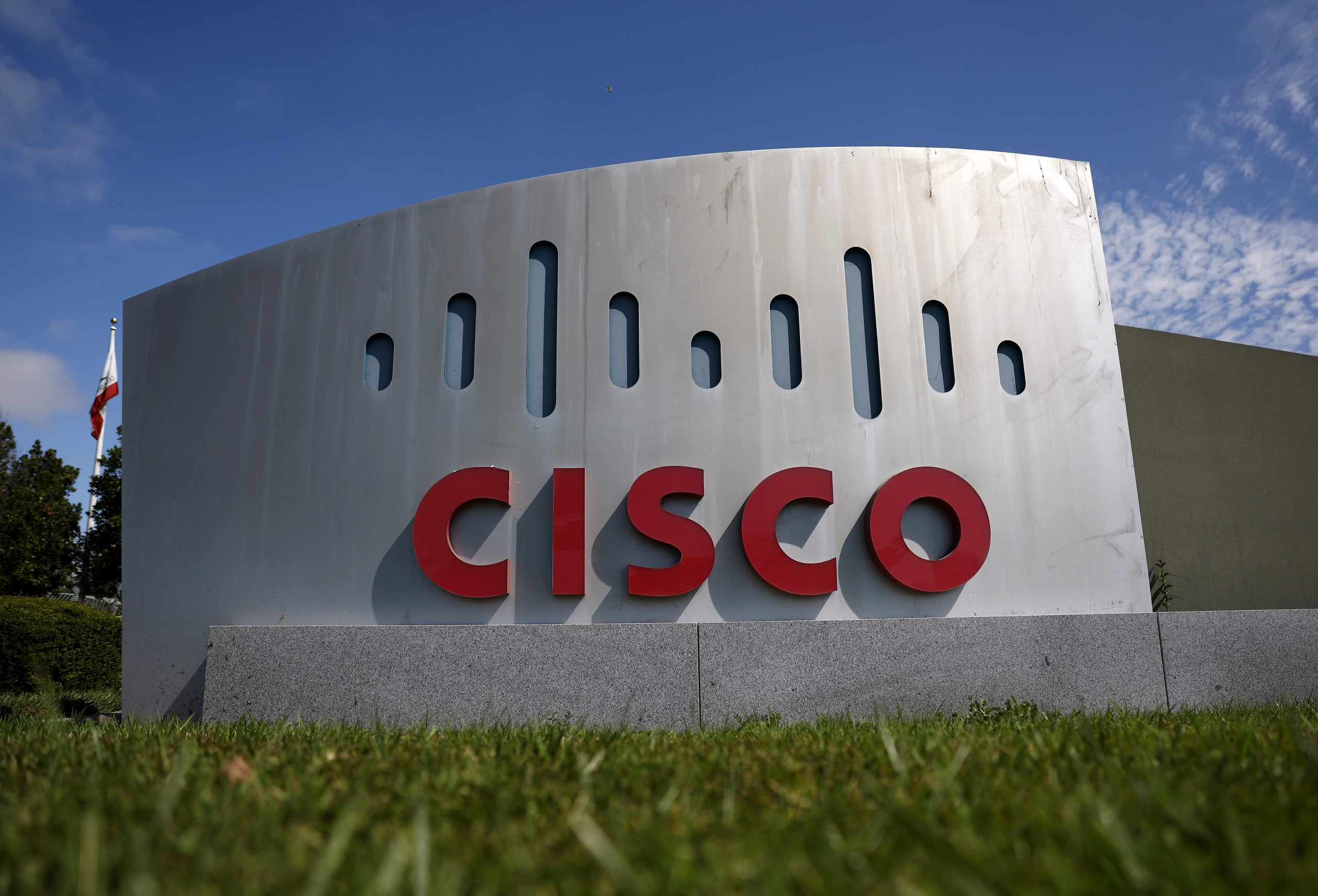
Cisco Systems shares spiked higher Wednesday evening after the networking company delivered a quarterly beat and outlook raise. Another quarter of double-digit order growth proves Cisco is an underrated winner from the AI infrastructure buildout. Revenue in the company’s fiscal 2026 first quarter, which ended Oct. 25, increased 8% year over year to $14.88 billion, exceeding the LSEG-complied analyst consensus estimate of $14.76 billion. Non-GAAP earnings increased 10% on an annual basis to $1 per share, beating expectations of 98 cents, LSEG data showed. GAAP stands for generally accepted accounting principles. CSCO YTD mountain Cisco Systems YTD Look at the shares of Cisco go. They surged more than 7% in after-hours trading to just about $80 per share. That’s on top of a 3% move in regular trading hours. If the stock can take out $80.06, it will make its first all-time high since March 2000. Shares, as of Wednesday’s close, rose roughly 25% year to date. Bottom line It’s a deserving move after an excellent quarter, highlighted by accelerating product order growth, especially from artificial intelligence customers. During the post-earnings call, Cisco CEO Chuck Robbins attributed the strength in AI orders to a “deepening” relationship with existing customers. The company also called out that a “major multi-year, multi-billion-dollar campus networking refresh cycle” is underway. It wasn’t all perfect, however, as the security business missed estimates, with revenue falling year over year. According to management, some revenue recognition timing issues need to be sorted out. Security weakness was our main concern ahead of the quarter. The business also missed revenue estimates in the prior quarter, and we didn’t think a quick turnaround was likely. Our fear of this repeat was the main reason why we took some profits in this position Monday at around $71. Even though we were right to be cautious on security, the market was turning a blind eye to this issue because of how fast networking is growing. A rebound in security also isn’t needed for management to hit on its outlook, which was raised well above Street estimates Wednesday evening. Another concern of the bears entering earnings was that Cisco would be negatively impacted by the government shutdown due to its large federal agencies business. Despite the closed government, Robbins noted this business managed to grow orders by a high single-digit percentage in the quarter. He’s anticipating upside in orders once the government reopens. Why we own it Cisco Systems is an enterprise networking equipment provider that has made big strides to appeal to cloud customers. The company has also increased its presence in the security market through its acquisition of Splunk. In addition, Cisco’s long-term transition toward subscription software sales, which are sticky and come with higher margins, should help improve the stock’s undemanding price-to-earnings multiple. Competitors : Arista Networks , Hewlett Packard Enterprise , Juniper Networks Most recent buy : Aug. 19, 2025 Initiated : July 17, 2025 The story remains that Cisco has turned into a sleeper AI play thanks to the billions of dollars it is taking in from hyperscaler customers. That surge of orders is converting to big revenue. In fiscal year 2025, Cisco recognized roughly $1 billion of AI revenue from hyperscalers, which are the biggest of the Big Tech names, such as the major cloud companies. On the call, Robbins said he expects to recognize roughly $3 billion from hyperscalers in fiscal year 2026. Despite this accelerating growth and subscription revenue making up more than half of its total revenue, the stock still trades at a reasonable price-to-earnings multiple of about 19.5 times based on the new midpoint of management’s full-year adjusted earnings-per-share (EPS) outlook. We’re reiterating our 2 rating because we don’t like to chase stock spikes, but we are increasing our price target to $85 per share from $78. Commentary Total Product orders increased 13% year over year – an acceleration from 7% growth in the prior quarter – with growth across all geographies and customer markets. When we review Cisco, we always focus on orders because that’s the best leading indicator of where revenue is headed. Product revenue grew 10% year over year to $7.77 billion, beating estimates of about $7.47 billion. Starting with the Networking sub-segment, product orders increased by a high teens rate, representing the fifth consecutive quarter of double-digit growth. AI infrastructure orders from hyperscaler customers were a big driver of that growth. Cisco took in $1.3 billion of orders in the quarter, an acceleration from the more than $800 million in the prior quarter. The company also saw strong orders for enterprise routing, campus switching, wireless, industrial IoT, and servers. Credit Cisco’s close relationships with portfolio name Nvidia and Advanced Micro Devices for its recent AI success. Last month, Cisco announced the N9100, which they called the first Nvidia partner developed data center switch based on Nvidia Spectrum-X Ethernet switch silicon. “The N9100, available in the second half of fiscal year 2026, will provide the operational consistency and flexibility needed for sovereign and neocloud providers to build and manage AI at scale,” Robbins explained. Neoclouds are next-generation specialized clouds for accelerated computing. CoreWeave , which rents cloud-based Nvidia chips for AI tasks, is an example of a neocloud. Cisco is also helping G42, leading United Arab Emirates AI firm, with powering, connecting, and securing its large-scale AI clusters with AMD graphics processing units (GPUs) The enterprise AI story is starting to emerge, too. Cisco experienced strong demand for switching, routing, and wireless products, which Robbins said is an indication of customers “investing in the connectivity needed for AI deployments.” Across sovereign, neocloud, and enterprise customers, Robbins called out a growing pipeline above $2 billion for its high performance networking products. This comes after Cisco booked $200 million of orders in its fiscal first quarter from these customers. By division, Networking revenue increased 15% to $7.77 billion, beating estimates. The largest driver of this increase in sales was from service provider routing, which is mostly from AI infrastructure. Data center switches and enterprise routing were also up double digits, while campus switching revenue increased by a high single digit percentage. In the Security division, revenue fell 2% year over year and missed analysts’ forecasts again. It’s disappointing to see a sizeable miss in back-to-back quarters, but management attributed the decline to a timing issue. Robbins explained that more customers are using Splunk’s offerings through cloud subscriptions instead of on-premise deals, leading to a timing change of when revenue is recognized. Ultimately, this transition isn’t a bad thing. The company is in favor of more subscription-based revenue. Cisco completed its $28 billion acquisition of Splunk in March 2024. “We are actually pleased to see more cloud subscriptions for Splunk as they enable greater adoption and expansion, and allow us to deliver innovation faster to enable customers to unlock value from AI Now ” Robbins explained on the call. More broadly. Cisco said it continued to see order growth for some of it newer and refreshed security products, which make up about one third of the portfolio, while its order products are in decline. Importantly, management doesn’t believe Security’s stumbles will last long. They expect revenue growth to accelerate and end the year at a much higher rate. But even if that doesn’t happen and the results don’t materially improve from here, Cisco said it’s still confident in its ability to deliver on its fiscal Q2 and full year 2026 outlook. The Collaboration and Observability units saw revenue drop 3% and rise 6%, respectively, with Collaboration missing estimates and Observability matching expectations. Services revenue increased 2% year over year to $3.81 billion, slightly beating estimates. As always, we appreciate Cisco’s consistent approach to returning cash to shareholders. The company repurchased $2 billion worth of shares in the quarter at an average price of $68.28. That looks like a great trade since the stock is knocking on the door of $80 in after-hours trading. It has $12.2 billion remaining under its authorization. Cisco stock, as of Wednesday’s closing price, has a 2.2% annual dividend yield. Guidance Cisco expects fiscal 2026 second-quarter revenue of $15 billion to $15.2 billion, which is well above the consensus estimate of $14.62 billion. It also sees non-GAAP EPS of $1.01 to $1.03 cents, which is nicely above the consensus estimate of 98 cents. For full year 2026, Cisco now expects revenue of $60.2 billion to $61 billion, which is about a $1 billion increase from the prior outlook of $59 billion to $60 billion. This revised outlook exceeds the consensus estimate of $59.64 billion. On the bottom line, management raised its EPS forecast to $4.08 to $4.14 from its prior outlook of $4.00 to $4.06. This new midpoint of $4.11 is better than the consensus analyst estimate by 7 cents. (Jim Cramer’s Charitable Trust is long CSCO, NVDA. See here for a full list of the stocks.) As a subscriber to the CNBC Investing Club with Jim Cramer, you will receive a trade alert before Jim makes a trade. Jim waits 45 minutes after sending a trade alert before buying or selling a stock in his charitable trust’s portfolio. If Jim has talked about a stock on CNBC TV, he waits 72 hours after issuing the trade alert before executing the trade. THE ABOVE INVESTING CLUB INFORMATION IS SUBJECT TO OUR TERMS AND CONDITIONS AND PRIVACY POLICY , TOGETHER WITH OUR DISCLAIMER . NO FIDUCIARY OBLIGATION OR DUTY EXISTS, OR IS CREATED, BY VIRTUE OF YOUR RECEIPT OF ANY INFORMATION PROVIDED IN CONNECTION WITH THE INVESTING CLUB. NO SPECIFIC OUTCOME OR PROFIT IS GUARANTEED.









